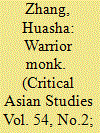|
|
|
Sort Order |
|
|
|
Items / Page
|
|
|
|
|
|
|
| Srl | Item |
| 1 |
ID:
183811


|
|
|
|
|
| Summary/Abstract |
This article tells the intertwined tales of two historical routes that testify to the extensive geographical distance and profound political connections between Tibet and China throughout the modern era. In much of the eighteenth and nineteenth centuries, the Sichuan Route operated as the transportation artery upon which the Qing empire depended to maintain authority in Kham and Tibet. It was also the site of a rite of passage for frontier functionaries and a meeting ground between imperial agents and the indigenous population. Despite its destruction after the implosion of the Qing in 1911, the histories and memories of the Sichuan Route continued to influence decision-makers in both China and Tibet in the following decades. The Maritime Route, which emerged in the late nineteenth century with the proliferation of steam transportation in Asia, revolutionized the way in which Tibet connected to China and the rest of the world. It also competed with the Sichuan Route and encouraged the Qing to reconfigure its presence in its non-Chinese territories in the southwest. After the empire fell, political tensions continued to evolve around the Maritime Route, which functioned simultaneously as the reluctant choice of Chinese emissaries and a strategic tool that the Lhasa government wielded to curtail China's influence. Through an exploration of the Sichuan Route and the Maritime Route on the levels of experience and representation, this article sketches the two routes’ troubled interconnections with each other and with every twist and turn in Sino-Tibetan relations from the eighteenth to the twentieth centuries.
|
|
|
|
|
|
|
|
|
|
|
|
|
|
|
|
| 2 |
ID:
185933


|
|
|
|
|
| Summary/Abstract |
This article revisits the Ninth Panchen Lama’s (Choekyi Nyima, 1883–1937) controversial exile in China and Inner Mongolia between 1924 and 1937. As the most renowned political dissenter of the then-nascent Tibetan state and the second most important religious leader for Mongolian and Tibetan Buddhists, the Ninth Panchen Lama played a significant role in the early-twentieth-century Chinese, Tibetan, and Mongolian political and spiritual worlds. Academic scrutiny of the Ninth Panchen Lama’s association with China has facilitated the scholarly understanding of the “subimperialist” policy that the Chinese Nationalist government devised to replicate the Qing Empire’s success in managing Mongol and Tibetan territories. Assisted by newly released sources and a shifting focus away from Chinese statesmen to the Tibetan monk, this article reassesses the power that the Ninth Panchen Lama wielded on the Sino–Mongol–Tibetan frontiers and his collaboration with the Chinese Nationalist government. This article argues that despite possessing many cosmetic features of the Qing-style relationship centering on the mutually agreed reinterpretation of an established status quo within a hierarchal framework, the alliance between the Ninth Panchen Lama and the Chinese Nationalist government was a venturesome entente based upon shared objectives that were audacious, contentious, and bore little resemblance to Qing precedent.
|
|
|
|
|
|
|
|
|
|
|
|
|
|
|
|
| 3 |
ID:
185935


|
|
|
|
|
| Summary/Abstract |
In 1935, the Chinese central government, controlled at the time by the Nationalist Party (KMT), announced a diplomatic mission to escort the exiled Ninth Panchen Lama (Choekyi Nyima, 1883–1937) back to his monastic seat, the Tashilhunpo Monastery in Shigatse, Tibet. Zhuang Xueben (1909–1984), a twenty-six-year-old photographer, approached the head of the delegation, special emissary Chengyun, and volunteered to join. Chengyun, who had not yet recruited a photographer for the mission, welcomed Zhuang to the team.
|
|
|
|
|
|
|
|
|
|
|
|
|
|
|
|
|
|
|
|
|